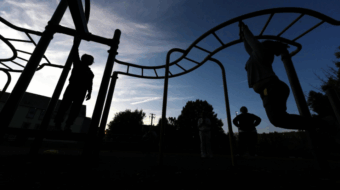This is a volatile moment. The class struggle is intensifying and the outcome is still to be decided.
The battle is for the future – the future of our democracy, economy, and country.
On one side are the majority of the American people, buffeted by the economic crisis, angered by unconscionable inequalities, tired of war-making, worried about environmental catastrophes, and convinced that a “more perfect union” is within our reach.
On the other side are the upper-crusters and mammoth transnational corporations – the 1 percenters – who grow filthy rich off the labor of working people, live in luxury, corrupt our political life, and parade as patriots.
This is the backdrop to a marked upswing in the class struggle. Not for a while have things felt so unhinged.
Sustained nonviolent mass actions, civil disobedience, new levels of solidarity and consciousness, new creative forms of organization, tactics and slogans, and an array of social forces and organizations are dotting the political landscape in novel ways.
Some organizations – AFL-CIO, NAACP, Jobs with Justice, MoveOn, etc. – have been on the scene for a while. Others – Rebuild the Dream, the Occupy movement, Bottom Line, etc. – are relative newcomers. What is striking is the degree to which they blend and work together.
In an upsurge of any significant size and scope, new and spontaneous forms of organization and struggle are almost inevitable.
The people’s movement has to embrace the unfamiliar and new if it is to stay apace with the temper of the times. It has to adapt to new patterns and moods of struggle, if it hopes to help influence these developments in a positive direction.
The occupation of Wall Street is the most dramatic expression of a quickening struggle. Its politics don’t fit into any neat political category and its methods of organization are unorthodox. No single “ism” prevails. Nevertheless, most of the participants are on the progressive and left side even if they don’t characterize themselves in those terms.
While the occupiers don’t embrace a specific set of political demands, they are disgusted with Wall Street and Washington’s beholdenness to the lords of finance. Some observers see this as a grave weakness, but I don’t. This movement is in its early stages and brings together people of diverse political views. Its actions have shined the spotlight on Wall Street and thereby changed the national conversation away from right-wing anti-government chatter. It has turned the struggle against finance capital from a left issue into a broad top-bottom issue.
The occupations may seem to have come “out of the blue,” but they didn’t. Since the spring we have witnessed an uptick in class and democratic struggles on a global scale from Cairo to Athens and beyond.
In our own backyard, major struggles broke out in Wisconsin, Indiana, Ohio, and elsewhere.
And streams of young and older activists who threw themselves into the campaign to elect Barack Obama are looking for ways to leave their political mark going forward.
Thus, the occupation movement draws inspiration from and is rooted in home-grown and international struggles.
The largest constituency is young people. The young are energizing this movement, giving it flair and freshness.
Not only do the young participants want to curb the power of the banks and democratize our politics, but they also want to transform their own lives.
Some of what they do may seem far-fetched and removed from the realities of power, but maybe that speaks to our limited cultural and political imaginations.
The potential of further building a broad youth movement has never been greater. It could eclipse the youth rebellion of the 1960s. And that movement as we know left a definitive mark on the politics and culture of our country.
An immediate challenge is to energize and involve the rest of the young generation whose life prospects are grim. Any hope of any substantive victory now and in the future depends on their participation. This includes college campuses that are not yet plunged into struggle on a broad scale.
One would think that the economic conditions – unemployment, student debt, etc. – should propel young people into the struggle for jobs, equality and peace. But it doesn’t happen automatically; the same conditions can also result in a narrow focus on individual advancement.
What young people do hinges on many factors, including if the broader movement gives them support and space to express their specific concerns and styles and construct their own forms of organization.
Obviously the Occupy movement faces challenges. In some ways the least of them is articulation of a series of demands. Looming larger is how to expand the movement especially among the young; how to deepen and solidify relations to other key forces, especially labor; how to avoid unnecessary confrontations with the police that draw attention away from Wall Street robbery; how to reach youth of color and young women; and how to approach the 2012 elections.
Both as Occupy participants and as activists in social movements we should turn our attention to these challenges in a constructive way. This includes a vigorous response by the entire progressive and democratic community to attempts by local government to evict the occupiers from public space.
Photo: Occupy Chicago activists protest at the financial district. Pepe Lozano/PW.










